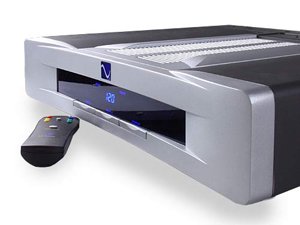A bit of background …
The mains supply could be seen to be at the very heart of the performance of your audio system. If you accept this then, If your mains is significantly distorted then effects flow through the electronics and end up distorting the reproduced sounds from your loudspeakers in a variety of subtle and not so subtle ways.
A mains supply re-generator uses reconstruction techniques to either build a mains waveform from scratch, or repair it ‘on the fly’ to produce a less distorted electrical sinewave.
Founded in 1974, PS Audio must be one of the longest established American hi-fi manufacturers. Headed up by hifi legend Paul McGowan, PS Audio has led the field in mains regeneration for hi fi and AV systems. In the late 1990s PS Audio announced the P300 mains re-generator. This introduced mains regeneration to the mass market – previously high end Japanese manufacturer Accuphase had already introduced a re-generator, but at a very high end price!
The P300 used the full reconstruction technique and converted the mains supply to DC and then built up a low distortion mains supply sinewave from that. Power output was limited to about 300W and so was useful for source equipment but couldn’t handle a decent sized power amp. The chassis also got seriously hot and it had a quite noisy fan! But apart from that it worked well. I bought one pretty much as soon as they were available in the UK and despite the issues mentioned I found it to be very beneficial sonically
Subsequent PS Audio ‘full’ re-generators provided more power but were very large and heavy and they gave out ever more heat requiring ever more fan ventilation. Not a recipe for harmony in the home! PS Audio then changed direction a little and ‘on the fly’ repair of the mains supply waveform became the objective. This required far less power and was also more cost effective.
The Power Plant Premier under review is capable of outputting 1500W of low distortion mains power and is housed in a very attractive chassis. It even has remote control!
More recently, the Power Plant P5 and P10 have been introduced. They have even higher power reserves, touch screen controls and can even connect to the internet – so you can send a signal from your iPhone as you are leaving work to power up your system so it’s nice and warmed up and ready to go as soon as you get home. Amazing really.
The Power Plant Premier (PPP) …
OK, let’s forget the history and the techie stuff. How does the PP Premier perform?
I think it looks fab in a sleek and sexy way.
On the rear, one mains input IEC socket, and 5 UK mains sockets to plug gear into. Of course, you can plug a mains block into one of the outlets if you have more than 5 components to be powered.
The blue display has 3 brightness settings and is dimmable from quite bright to very dim indeed, and off .
The display shows input and output values of both voltage and % Total Harmonic Distortion (THD).
The PPP can easily handle my full system, including the 250WPC Parasound A21 power amp. There’s a fan in the PPP that powers up for a few seconds when it is first turned on, but it has never yet come on while music is playing. I doubt it ever will, the chassis barely gets above gently warm even when the walls are flexing with the sound levels!
OK, on to the sonics …
I plugged my system’s components into it one at a time to assess the incremental improvements.
I started off with the Krell KRC-3 pre-amp … hmm, yes, quite a nice improvement. Images were a tad more solid, backgrounds a bit darker. Everything just a touch more tactile. Not too bad, but not really worth shouting about either.
Just a little dis-heartened I then plugged the ‘Big Mutha’ Parasound Halo A21 power amp in, no longer expecting too much … Bloody hell, I practically fell off my chair!
An astonishing improvement in a piece of kit I already held in very high regard (see separate Hifi Pig review of the A21).
At this point I was concerned about powering the CD player as well – I’m was afraid an usher would come round and ask me if I’d bought a ticket on the way in to the concert hall!
The CD player was then PPPed …. same sort of story as for the Krell pre-amp – small improvements.
To be honest, based on the PPP’s performance with source components I doubt I would keep it – I think there would be better ways to spend the money. But the performance enhancement with the power amp totally changes that result.
In summary, the improvements from using the Power Plant Premier with my Parasound A21 power amp …
1. substantially improved transparency
2. improved resolution of fine detail
3. blacker blacks, the silences are more silent. I thought I had a silent backdrop to recordings before, but I guess low level background grunge is only noticeable when you reduce it further!
4. all of which result in far better 3D holographic imaging and a vastly improved “you are there” experience.
As I said, I’ve previously owned a P300 …. it didn’t come close to this level of performance in terms of overall system improvement, but then you couldn’t run a big power amp from it, and that’s where I hear the main benefits of the Premier.
I guess other systems may respond differently, and other homes will have different quality mains as well.
For those who are curious about the fundamental technical performance of the PPP in my home … according to the readouts my mains voltage varies between 225V and 245V, the PPP always outputs 240V or very near it. And the incoming THD on the mains is usually between 2.5% and 3%, and the output from the PPP varies between 0.4% and 0.7%, a range which seems dependent on the amount of voltage correction that is needed.
Until quite recently the PPP was available in the UK for around £1500. My guess is that some dealers still have stock, maybe at reduced prices.


































































































































































































You must be logged in to leave a reply.